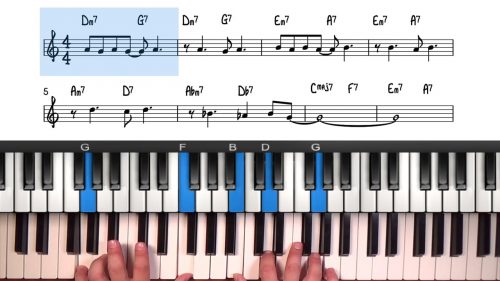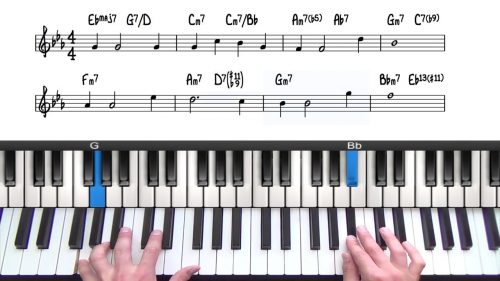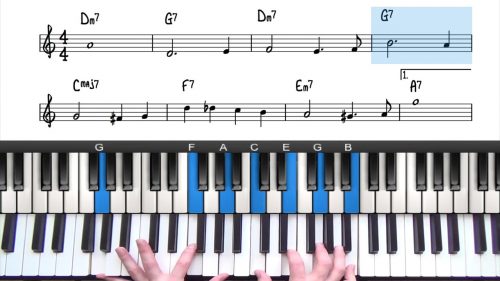Drop 2 Voicings For Jazz Piano
In this lesson I am going to explain what drop 2 voicings are, how to construct them and then how to practice drop 2 voicings so that you are familiar with them in all 12 keys.
We’ll also talk about how you can spot opportunities to harmonise the melodies of Jazz Standards using drop 2 voicings and also look at ways that these voicings can be used to create movement over static harmonies and melodies.
In the last lesson we introduced the 4 Way Close which is a simpler version of drop 2 and will help you understand the construction and application of the drop 2 voicings covered in this lesson.
What is a drop 2 voicing?
Drop 2 voicings can be heard in the recordings of almost all of the great jazz pianists and they are an extremely useful tool for harmonizing the melody of jazz standards.
Drop 2 was originally used in arranging for orchestras and big bands as it provided a way for 4 horn instruments to produce a very rich texture over a single chord.
Lesson Downloads
-
Drop 2 Voicings Lesson Transcript File Type: pdf
Practice Tips
-
First of all, you need to find a section of a jazz standard that would be suitable for drop 2 harmonisation. Flick through the standards you can play and look out for either stepwise melodic movement or sections of static harmonies and melodies.
-
Once you have found a suitable application, make note of the chord and then play the four way close for the whole scale. For example, if you find a stepwise melody over F Major chord. Harmonise the F Major scale with the rootless dominant b9 chord so that you are familiar with the voicings.
-
Once you can play the scale using the 4 way close, then drop the second note and go through the scale again. After practicing this you should then be comfortable with the voicing shapes and ready to add the interesting drop 2 textures into your playing
-
When you follow the process above you are learning these voicings in context, which is vitally important. At this stage, it's not essential that you can harmonise using drop 2 in all 12 keys. Just take a tune that you can already play and enhance your arrangements with drop 2 harmony.








Hi Hayden,
Quick question on drop 2 chords. I just realized I’ve been playing them while doubling the root note / not taking out the original bottom note from the 4 way close (basically, 4 way close position, just removing the 2nd from top note and adding it to the bottom – but leaving everything else).
I can definitely hear the difference – I’m just wondering if you’d ever decide to play it like that, or not, in your experience.
Thanks!
Clif
This lesson on drop 2 voicings introduces them as a way to harmonize melodies that ascend or descend stepwise in a scale.
My question is about learning to use drop 2 voicings to comp, for example in a blues. I saw Tuomo do this for several choruses in the really helpful transcription of Billy’s Bounce (pianogroove.com/jazz-piano-lessons/f-blues-billies-bounce/), which is a standard jazz blues in F.
The issue is that comping with drop 2 uses left hand rootless voicings, except in the right hand. I’ve got the types A and B rootless voicing shapes down in the left hand but not in the right.
I have been working out these drop 2 voicings for F blues a chord at a time, using Tuomo’s transcription, but this is not ideal.
My question is, Are there exercises or drills to learn drop 2 comping in a way that is transferable to all 12 keys? Do you think it’s worth making a lesson on this?
Many thanks for your thoughts.
Hi Jeremy 👋
Firstly, Tuomo is far more experienced than with comping than myself, and so perhaps he would be the best person to ask for this as I focus more on solo piano.
Regarding not knowing rootless voicings in the right hand, if you can play this drill in all 12 keys: pianogroove.com/jazz-piano-lessons/extended-251-progression-drill/ – then simply drop the root out of your left hand. Perhaps you can start by including the root very quietly whilst focusing most of your attention on the right hand chord structures; which are in effect rootless voicings once the root in the left hand is omitted.
My personal recommendation would be to take this around the whole step 251 sequence as outlined above. First work out the 2-handed drop 2 voicings for a 251 in C Major, and then move through the whole step sequence.
Then you can pick keys randomly, or switch between the 251s in intervals of major 3rds/minor 3rds, 4ths, 5ths etc… instead of always descending by whole steps as per the whole step 251 drill.
At this point you will be familiar with the progressions and the final step would be to apply this to the harmony the tunes you want to comp over, perhaps with a backing track.
Please see these 2 lessons which I created some time ago:
pianogroove.com/jazz-piano-lessons/2-handed-comping-voicings/
pianogroove.com/jazz-piano-lessons/quartal-comping-voicings-for-jazz-piano/
These are not drill-based like the whole step 251 drill for example, but I try to show how to apply the voicings to the tune “There Will Never Be Another You”.
I’m a big fan of the quartal comping voicings that I cover in the 2nd lesson and I have learnt those in all 12 keys which was quite a bit of work but definitely worth while. I was planning to do a whole-step 251 lesson on this and so I have just bumped that up on my upcoming lesson agenda.
I think the best thing to do would be to add a “comping module” to my whole step 251 course which focuses on rootless 2-handed spread voicings, quartal 251 voicings, and perhaps other comping voicing configurations such as rootless voicing left hand with stacked 4ths or 5ths in the right hand.
Let me know what you think to the lessons above, and also the idea of a whole-step comping module. Also feel free to post Tuomo a comment on one of his lessons to get his opinion and recommendations.
Talk soon,
Hayden
Dear Hayden
Thanks so much for getting back to me.
First, I really appreciate the pointer to the drills for right hand rootless voicings. I had forgotten about that lesson, and was very pleased that I really did remember how to play those voicings. Working out and drilling drop 2 voicings from those turned out to be quite straightforward, as the voice that gets dropped (in the main A and B inversions) are always 3’s and 7s. And adding a backing track is always a great idea to force one to face one’s weaknesses.
I know the two lessons your mention on 2-handed and quartal comping voicings well. They have been bookmarked for a long time, and I often come back to them.
I would be so pleased if you were to add a comping unit. Although you say that you focus on solo piano, implying that comping practice is for people playing in groups, I think that practicing comping is invaluable for the learner of solo piano: it allows one to practice two handed voicings all over the keyboard and get a much better feel for the harmony and structure of a tune, as one moves from voicing 2-5’s, to minor 2-5-1’s and 5 of 5 of 5’s, as the tune calls for. Comping also allows one to get a feel for playing at somewhat faster tempos than are possible when one is working on an arrangement of a tune that includes right hand melody and left hand chords. Comping is an excellent exercise to complement your terrific lessons on typically slower tunes. So, yes, please! A unit that focuses on comping over a few mid-tempo tunes as exercises in improving skills in two handed voicings would be very welcome indeed.
I am not sure what to ask Tuomo about comping. His transcribed lessons where he plays without talking are incredibly helpful because the transcriptions are so well annotated. However, his lessons about a particular topic are meant for players much more harmonically and technically advanced than I.
Finally, I have one general question that is unrelated to this topic:
Is there a way to ask you questions about problems with a tune that are not directly related to a particular lesson? For example, I have a question about what are likely common problems encountered by learners in arranging a tune. Do you read and respond to questions in the forum? And in what sub-forum?
As always, thank you so much for the quality of this course and for your dedication to supporting your students.
Thanks Jeremy – I’m glad the lesson recommendations were useful.
I will go over this theory and relationship in my seminar on the 15th of this month which focuses on rootless voicings. pianogroove.com/live-seminars/mastering-rootless-chord-voicings/
The extended 251 drill is a foundational exercise for so many other areas of jazz theory. Once we can play the extended 251 progression in all 12 keys then it’s easy to add, subtract, and alter notes to create a huge selection of 251s with different colours and tensions.
Sure thing, leave that with me. I already learnt the quartal 251s in all 12 keys so I’m ready to teach it in a whole step drill format.
Yes I’d recommend to post it here in the theory questions section: community.pianogroove.com/c/theory/11
I’d be more than happy to post a video response in there and any other relevant resources.
The lesson comments section is best for questions specific to the lesson, and for anything more general the forum is the best place to post it.
My pleasure, Jeremy!
Talk soon,
Hayden
Hi Hayden,
In the drop two lesson at about 5 minutes, you review the block voicing using c minor 7 but you play through the scale with a flat 6, flat7 and 7. Why is that?
Sherry
I also see that you play the flat7 and major 7
Hi Hayden,
The drop two concept explanation is very clear except that I don’t understand why you restrict application of the drop two chords as a modification to block chords. Couldn’t you use a drop two chord anywhere?
Hi Sherry,
Great question!
Yes, you are correct that Drop 2 can be applied to other voicing types, not just block chords. Block chords are one of the main applications which is why I covered it here in this course on block chords.
No, drop 2 cannot be applied anywhere. With an upper structure triad voicing for example – dominant shell in left hand and triad in the right hand – dropping the 2nd to top note from the right hand into the left hand would sound a little unusual in my opinion.
It very much depends on the style that you are playing. I like to play a ‘full solo piano sound’ which is octave melodies with chord tones added in between my right hand octaves, and then stride patterns in my left hand. For example, please see my recent seminar on Beegie Adair’s playing style: pianogroove.com/live-seminars/beegie-adair-harmony-improv/
Drop 2 is mainly applied to comping voicings and 2-handed spread voicings. In my own preferred style (stride and rootless voicings) the right hand is often busy with octaves and chord melodies. It’s simply a different approach. I may intersperse some drop 2 spread voicings into my playing here and there, but as you will see in the seminar above, the majority of what I play is stride left hand with rootless type a/b voicings.
As mentioned, Tuomo is an expert in drop 2 voicings and configurations so if you have more questions on the applications beyond my explanations on block chords, he will be able to assist you much better than I.
He also covers similar ideas in his lessons and seminars on Barry Harris Voicings:
pianogroove.com/?s=barry+harris
community.pianogroove.com/t/barry-harris-voicings/3120
Best,
Hayden